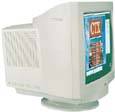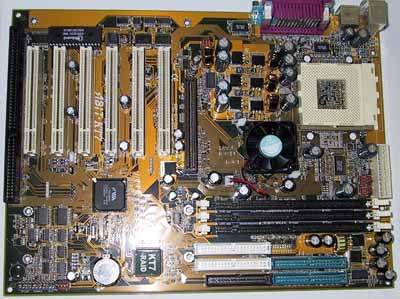Buyer's Guide: Value Systems - November 2000
by Mike Andrawes on November 25, 2000 3:06 PM EST- Posted in
- Guides
Value Gaming
The concept behind this
system is simple - the best balance of high frame rates and a reasonable price.
 Processor
– AMD Duron 700 - $75
Processor
– AMD Duron 700 - $75
The Duron is perfect for our Value Gaming system since it performs within
5 - 10% of the regular Athlon. If you feel like overclocking, the Duron 700's
that we've tested have run at 900 - 950 MHz by simply boosting the voltage and
changing the clock multiplier. Of course, overclocking AMD's Socket-A CPU's,
including the Duron, has been the center of much controversy, but it's quite
easy with the right motherboard and the correct information. For full details
on overclocking the Duron, read our AMD Thunderbird
& Duron Overclocking Revealed Article and the "What
to look for in a KT133 Motherboard" section of our Socket-A
Motherboard Roundup for August 2000.
If you feel like spending about $50 more, you can get a Duron 800 but since you'll be limited by the memory bandwidth of your video card at the higher resolutions we decided that the extra 100MHz wouldn't help that much in games. As far as overclocking goes, the higher rated core seems to make no difference as our Duron 800's also topped out around 900 - 950 MHz.
For more information on all Duron processors, read our AMD Duron review.
Motherboard – ABIT KT7
- $125
We recently looked at as many Socket-A
boards as we could get a hold of and one board stood out head and shoulders
above the rest - the ABIT KT7-RAID. While
that board is a bit expensive for a value system, ABIT still has a solution
for everyone, including the budget-conscious. By dropping the "RAID"
part of the product name, and the associated RAID features, the KT7 is available
for a much more reasonable $125. As we noted in the roundup, the KT7 is the
perfect board to overclock with thanks to its completely jumperless Soft Menu
III CPU setup.
The Asus A7V is also an excellent choice that also offers complete overclocking/multiplier control, albeit not in 100% jumperless form. The MSI K7T Pro2 should be hitting the streets soon as well, with new and improved overclocking options, including multiplier manipulation. We expect that the K7T Pro2 will probably become the motherboard of choice in the value systems since it will probably cost about $10-20 less than the ABIT KT7 or Asus A7V, but availability is still low. One last option is the EPoX EP-8KTA2, which also offers all the overclocking features of the KT7 (not jumperless though), but also adds the VIA 686B south bridge that includes Ultra ATA 100 support.
For more information, read our ABIT KT7-RAID Review, Asus A7V Review, MSI K7T Pro2 Review, EPoX EP-8KTA2 Review and Socket-A KT133 Motherboard Roundup.
Memory – 128MB Nanya
or Mushkin Budget PC133 SDRAM - $80
SDRAM prices are
finally back on the way down and they sure are dropping fast! Last month the
Mushkin Budget memory that we're recommending here was $140, but has dropped
almost 50% to $80 now.
Mushkin Budget
PC133 w/ Nanya chips

Click to Enlarge
While we can't point you in the direction of our usual recommendation of 128MB Corsair PC133 SDRAM due to cost, Mushkin's Budget PC133 SDRAM which we included in our latest PC133 SDRAM Roundup actually makes use of NANYA SDRAM chips which happened to work fairly well as you can see from our roundup.
Video card – NVIDIA GeForce2
MX - $110
This month, we've moved to an NVIDIA GeForce2 MX based card for our value
gaming system. In virtually every situation, the MX performs like the older
GeForce 256 SDR, but costs $30-50 less than that older model. The MX does have
the advantage of a higher clocked core, and thus greater theoretical fillrate
and T&L speeds.
On the overclocking side, the 0.18-micron core of the GeForce2 MX allows for considerable core overclocking, even without a heatsink. However, memory bandwidth is where the bottleneck is, and thus overclocking the memory is the most efficient way to boost the performance of these cards. Read our GeForce2 MX Overclocking Guide for all the details.
GeForce2 MX cards are still just showing up on the market, so we can't recommend any particular model just yet. We've seen prices in the $110 range, with a few vendors dipping as low as $95 on some models. Note that a few GeForce2 MX's are available for even less, but with just 16MB of RAM. With the relatively small price differential, it's simply not worth cutting the memory in half at this point in time.
For more information, see our NVIDIA GeForce2 MX Review.
 Monitor
– CTX VL950SL - $300
Monitor
– CTX VL950SL - $300
Monitors are one of the few computer components that you can usually hang
onto for years to come. With that in mind, we didn’t want to go with anything
smaller than a 19” on our value gaming system – besides, once you’ve gamed on
a monitor this big, there’s no going back.
The best deal we could find on a 19” monitor was the CTX VL950SL, which will run you about $300. It’s a shortneck model that uses the same 0.26 mm dot pitch tube that many of the bigger brands use. For a bit more, just about every monitor manufacturer is offering a value 19" model that would fit the bill.











0 Comments
View All Comments